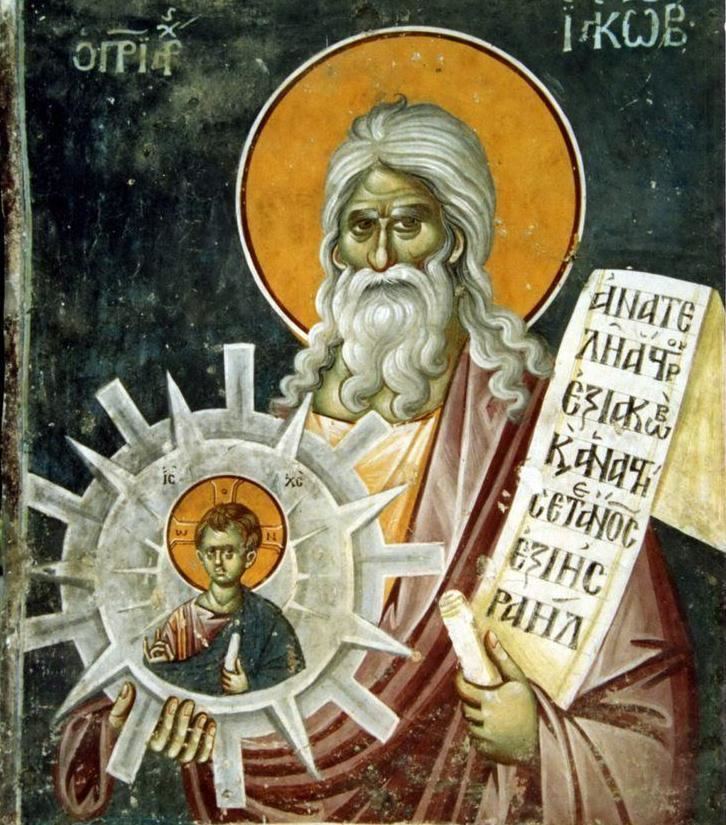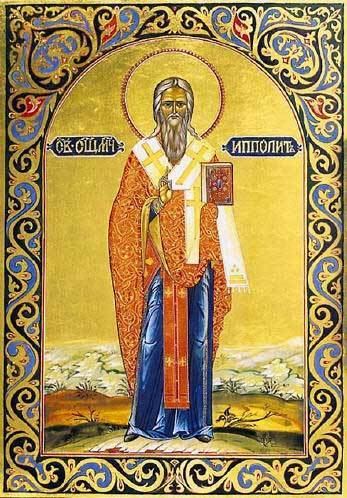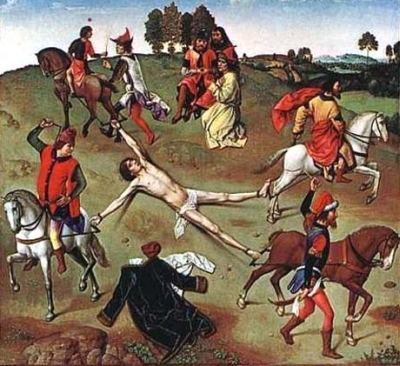Canonized Pre-Congregation Name Hippolytus Rome | Role Theologian | |
 | ||
Venerated in Roman Catholic ChurchEastern Orthodox ChurchOriental Orthodox ChurchAnglican CommunionEcclesia Gnostica Catholica Feast Roman Catholic Church: August 13Eastern Orthodox Church: January 30Coptic Orthodox Church: Meshir 6 Books Refutation of All Heresies, Apostolic Tradition, On the Apostolic Tradition, The Extant Works And Fragment, The Apostolic Tradition Similar People Pope Pontian, Pope Clement I, Pope Leo I, Pope Anterus, Pope Anicetus | ||
Treatise on christ and antichrist hippolytus of rome 1 of 5
Hippolytus of Rome (170 – 235 AD) was one of the most important 3rd-century theologians in the Christian Church in Rome, where he was probably born. Photios I of Constantinople describes him in his Bibliotheca (cod. 121) as a disciple of Irenaeus, who was said to be a disciple of Polycarp, and from the context of this passage it is supposed that he suggested that Hippolytus so styled himself. However, this assertion is doubtful. He came into conflict with the popes of his time and seems to have headed a schismatic group as a rival to the Bishop of Rome. He opposed the Roman bishops who softened the penitential system to accommodate the large number of new pagan converts. However, he was very probably reconciled to the Church when he died as a martyr.
Contents
- Treatise on christ and antichrist hippolytus of rome 1 of 5
- Treatise on christ and antichrist hippolytus of rome 4 of 5
- Life
- Legends
- Writings
- Eschatology
- Feast days
- References

Starting in the 4th century AD, various legends arose about him, identifying him as a priest of the Novatianist schism or as a soldier converted by Saint Lawrence. He has also been confused with another martyr of the same name. Pius IV identifies him as "Saint Hippolytus, Bishop of Pontus" who was martyred in the reign of Alexander Severus through his inscription on a statue found at the Church of St. Lawrence in Rome and kept at the Vatican as photographed and published in Brunsen.

Treatise on christ and antichrist hippolytus of rome 4 of 5
Life

As a presbyter of the church at Rome under Pope Zephyrinus (199 – 217 AD), Hippolytus was distinguished for his learning and eloquence. It was at this time that Origen of Alexandria, then a young man, heard him preach.

He accused Pope Zephyrinus of modalism, the heresy which held that the names Father and Son are simply different names for the same subject. Hippolytus championed the Logos doctrine of the Greek apologists, most notably Justin Martyr, which distinguished the Father from the Logos ("Word"). An ethical conservative, he was scandalized when Pope Callixtus I (217 – 222 AD) extended absolution to Christians who had committed grave sins, such as adultery.
Hippolytus himself advocated an excessive rigorism. At this time, he seems to have allowed himself to be elected as a rival Bishop of Rome, and continued to attack Pope Urban I (222 – 230 AD) and Pope Pontian ( 230 – 235 AD). G. Salmon suggests that Hippolytus was the leader of the Greek-speaking Christians of Rome. Allen Brent sees the development of Roman house-churches into something akin to Greek philosophical schools gathered around a compelling teacher.
Under the persecution at the time of Emperor Maximinus Thrax, Hippolytus and Pontian were exiled together in 235 AD to Sardinia, likely dying in the mines. It is quite probable that, before his death there, he was reconciled to the other party at Rome, for, under Pope Fabian (236–250), his body and that of Pontian were brought to Rome. The so-called chronography of the year 354 (more precisely, the Catalogus Liberianus, or Liberian Catalogue) reports that on August 13, probably in 236 AD, the two bodies were interred in Rome, that of Hippolytus in a cemetery on the Via Tiburtina, his funeral being conducted by Justin the Confessor. This document indicates that, by about 255 AD, Hippolytus was considered a martyr and gives him the rank of a priest, not of a bishop, an indication that before his death the schismatic was received again into the Church.
Legends
The facts of his life as well as his writing were soon forgotten in the West, perhaps by reason of his criticism of the bishops of Rome and because he wrote in Greek. Pope Damasus I dedicated to him one of his famous epigrams, making him, however, a priest of the Novatianist schism, a view later accepted by Prudentius in the 5th century in his "Passion of St Hippolytus". In the Passionals of the 7th and 8th centuries he is represented as a soldier converted by Saint Lawrence, a legend that long survived in the Roman Breviary. He was also confused with a martyr of the same name who was buried in Portus, of which city he was believed to have been a bishop, who was put to death by drowning in a deep well.
According to Prudentius' account, Hippolytus was dragged to death by wild horses, a striking parallel to the story of the mythological Hippolytus, who was dragged to death by wild horses at Athens. He described the subterranean tomb of the saint and states that he saw there a picture representing Hippolytus’ execution. He also confirms August 13 as the date on which a Hippolytus was celebrated but this again refers to the convert of Lawrence, as preserved in the Menaion of the Eastern Orthodox Church.
The latter account led to Hippolytus being considered the patron saint of horses. During the Middle Ages, sick horses were brought to St Ippolyts, Hertfordshire, England, where a church is dedicated to him.
Writings
Hippolytus' principal work is the Refutation of all Heresies. Of its ten books, Book I was the most important. It was long known and was printed (with the title Philosophumena) among the works of Origen. Books II and III are lost, and Books IV–X were found, without the name of the author, in a monastery of Mount Athos in 1842. E. Miller published them in 1851 under the title Philosophumena, attributing them to Origen of Alexandria. They have since been attributed to Hippolytus.
In 1551 a marble statue of a seated figure (originally female, perhaps personifying one of the sciences) was purportedly found in the cemetery of the Via Tiburtina and was heavily restored. On the sides of the seat was carved a paschal cycle, and on the back the titles of numerous writings by Hippolytus. Many other works are listed by Eusebius of Caesarea and Jerome.
Hippolytus' voluminous writings, which for variety of subject can be compared with those of Origen of Alexandria, embrace the spheres of exegesis, homiletics, apologetics and polemic, chronography, and ecclesiastical law. Hippolytus recorded the first liturgical reference to the Virgin Mary, as part of the ordination rite of a bishop.
Of exegetical works usually attributed to Hippolytus, the best preserved are the Commentary on the Prophet Daniel and the Commentary on the Song of Songs. This is the earliest attested Christian interpretation of the Song, covering only the first three chapters to Song 3:7.
The commentary on the Song of Songs survives in two Georgian manuscripts, a Greek epitome, a Paleo-Slavonic florilegium, and fragments in Armenian and Syriac as well as in many patristic quotations, especially in Ambrose of Milan's Exposition on Psalm 118 (119). It is generally regarded as an instruction relating to a post-Baptismal rite of anointing with oil as a symbol of receiving the Holy Spirit. The commentary was originally written as part of a mystagogy, an instruction for new Christians. Scholars have usually assumed the Commentary On the Song of Songs was originally composed for use during Passover, a season favored in the West for Baptism. Hippolytus supplied his commentary with a fully developed introduction known as the schema isagogicum, indicating his knowledge of the rhetorical conventions for teachers discussing classical works. He employs a common rhetorical trope, ekphrasis, using images on the walls or floors of Greco-Roman homes, and in the catacombs as paintings or mosaics. Origen felt that the Song should be reserved for the spiritually mature and that studying it might be harmful for the novice.
About 215, he wrote the Apostolic Tradition, which contains the earlier known ritual of ordination. The influence of Hippolytus was felt chiefly through his works on chronography and ecclesiastical law. His chronicle of the world, a compilation embracing the whole period from the creation of the world up to the year 234, formed a basis for many chronographical works both in the East and West.
In the great compilations of ecclesiastical law that arose in the East since the 3rd century, the Church Orders many canons were attributed to Hippolytus, for example in the Canons of Hippolytus or the Constitutions through Hippolytus. How much of this material is genuinely his, how much of it worked over, and how much of it wrongly attributed to him, can no longer be determined beyond dispute, however a great deal was incorporated into the Fetha Negest, which once served as the constitutional basis of law in Ethiopia — where he is still remembered as Abulides. During the early 20th century the work known as The Egyptian Church Order was identified as the Apostolic Tradition and attributed to Hippolytus; nowaday this attribution is hotly contested.
Differences in style and theology lead some scholars to conclude that some of the works attributed to Hippolytus actually derive from a second author. Two small but potentially important works, On the Twelve Apostles of Christ and On the Seventy Apostles of Christ, are often neglected because the manuscripts were lost during most of the church age and then found in Greece in the 19th century. As most scholars consider them to not have been written by him, they are often ascribed to "Pseudo-Hippolytus". The two are included in an appendix to the works of Hippolytus in the voluminous collection of Early Church Fathers. The work on the 70 apostles is noteworthy as a (potentially) early source.
Eschatology
Hippolytus is an important figure in the development of Christian eschatology. In On Christ and the Antichrist and Commentary on the Prophet Daniel Hippolytus gave his interpretation of Bible prophecies.
With the onset of persecutions during the reign of Septimus Severus, many early Christian writers turned to eschatology. On Christ and the Antichrist is one of his earliest works. Hippolytus was greatly influenced by Irenaeus. However, unlike Irenaeus, Hippolytus focus on the meaning of prophecy for the Church in his own time. Of the dogmatic works, On Christ and the Antichrist survives in a complete state and was probably written about 202.
The Commentary on the Prophet Daniel is the oldest extant scripture commentary. Hippolytus follows the long-established usage in interpreting Daniel's seventy prophetic weeks to be weeks of literal years. Hippolytus gave an explanation of Daniel's paralleling prophecies of chapters 2, 7, and 8, which he, as with the other fathers, specifically relates to the Babylonians, Medo-Persians, Greeks, and Romans. His interpretation of events and their significance is Christological. He stated that Rome would be partitioned into ten kingdoms and these in turn would be followed by the rise of the dread Antichrist, who would oppress the saints. This would be ended by Christ's Second Advent, the resurrection of the righteous, and the destruction of aid Antichrist. After which would come the judgment and burning up of the wicked.
Hippolytus did not subscribe to the belief that the Second Coming was imminent. He was apparently the first to set a specific date for the second Advent through calculation—A.D. 500—which was 260 years after his time. He assumed, like Irenaeus his teacher, that inasmuch as God made all things in six days, and these days symbolize a thousand years each, in six thousand years from the creation the end will come. He apparently based his calculation on the Septuagint which had the world beginning about 5500 B.C.
Feast days
In the Eastern Orthodox Church, the feast day of St Hippolytus falls on August 13, which is also the Apodosis of the Feast of the Transfiguration. Because on the Apodosis the hymns of the Transfiguration are to be repeated, the feast of St. Hippolytus may be transferred to the day before or to some other convenient day. The Eastern Orthodox Church also celebrates the feast of "St Hippolytus Pope of Rome" on January 30, who may or may not be the same individual.
The Roman Catholic Church celebrates St Hippolytus jointly with St Pontian on August 13. The feast of Saint Hippolytus formerly celebrated on 22 August as one of the companions of Saint Timotheus was a duplicate of his 13 August feast and for that reason was deleted when the General Roman Calendar was revised in 1969. Earlier editions of the Roman Martyrology referred to the 22 August Hippolytus as Bishop of Porto. The Catholic Encyclopedia sees this as "connected with the confusion regarding the Roman presbyter resulting from the Acts of the Martyrs of Porto. It has not been ascertained whether the memory of the latter was localized at Porto merely in connection with the legend in Prudentius, without further foundation, or whether a person named Hippolytus was really martyred at Porto, and afterwards confounded in legend with Hippolytus of Rome." This opinion is shared by a Benedictine source.
Earlier editions of the Roman Martyrology also mentioned on 30 January a Hippolytus venerated at Antioch, but the details it gave were borrowed from the story of Hippolytus of Rome. Modern editions of the Roman Martyrology omit all mention of this supposed distinct Saint Hippolytus of Antioch.
